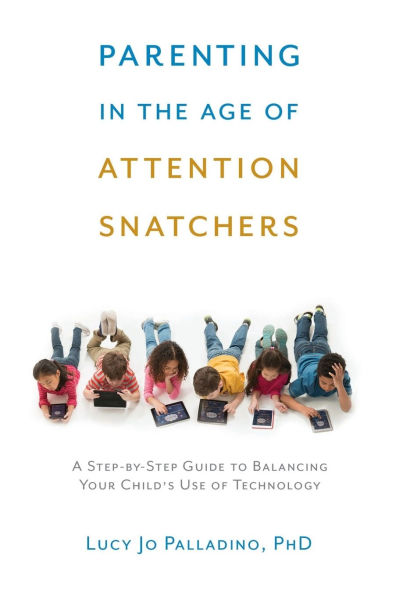Parenting in the Age of Attention Snatchers: A Step-by-Step Guide to Balancing Your Child's Use of Technology
Are your kids unable to step away from the screens? Here is a practical, step-by-step guide that gives parents the tools to teach children, from toddlers to teens, how to gain control of their technology use.
As children spend more of their time on tablets and smartphones, using apps specially engineered to capture their attention, parents are concerned about the effects of so much technology use—and feel powerless to intervene. They want their kids to be competent and competitive in their use of technology, but they also want to prevent the attention problems that can develop from overuse. Lucy Jo Palladino shows that the key is to help kids build awareness and control over their own attention, and in this guide she gives parents the tools to do exactly that, in seven straightforward, evidence-based steps.
Parents will learn the best practices to guide children to understand and control their attention—and to recognize and resist when their attention is being "snatched." This approach can be modified for kids of all ages. Parents will also learn the critical difference between voluntary and involuntary attention, new findings about brain development, and what puts children at risk for attention disorders.
1120054931
As children spend more of their time on tablets and smartphones, using apps specially engineered to capture their attention, parents are concerned about the effects of so much technology use—and feel powerless to intervene. They want their kids to be competent and competitive in their use of technology, but they also want to prevent the attention problems that can develop from overuse. Lucy Jo Palladino shows that the key is to help kids build awareness and control over their own attention, and in this guide she gives parents the tools to do exactly that, in seven straightforward, evidence-based steps.
Parents will learn the best practices to guide children to understand and control their attention—and to recognize and resist when their attention is being "snatched." This approach can be modified for kids of all ages. Parents will also learn the critical difference between voluntary and involuntary attention, new findings about brain development, and what puts children at risk for attention disorders.
Parenting in the Age of Attention Snatchers: A Step-by-Step Guide to Balancing Your Child's Use of Technology
Are your kids unable to step away from the screens? Here is a practical, step-by-step guide that gives parents the tools to teach children, from toddlers to teens, how to gain control of their technology use.
As children spend more of their time on tablets and smartphones, using apps specially engineered to capture their attention, parents are concerned about the effects of so much technology use—and feel powerless to intervene. They want their kids to be competent and competitive in their use of technology, but they also want to prevent the attention problems that can develop from overuse. Lucy Jo Palladino shows that the key is to help kids build awareness and control over their own attention, and in this guide she gives parents the tools to do exactly that, in seven straightforward, evidence-based steps.
Parents will learn the best practices to guide children to understand and control their attention—and to recognize and resist when their attention is being "snatched." This approach can be modified for kids of all ages. Parents will also learn the critical difference between voluntary and involuntary attention, new findings about brain development, and what puts children at risk for attention disorders.
As children spend more of their time on tablets and smartphones, using apps specially engineered to capture their attention, parents are concerned about the effects of so much technology use—and feel powerless to intervene. They want their kids to be competent and competitive in their use of technology, but they also want to prevent the attention problems that can develop from overuse. Lucy Jo Palladino shows that the key is to help kids build awareness and control over their own attention, and in this guide she gives parents the tools to do exactly that, in seven straightforward, evidence-based steps.
Parents will learn the best practices to guide children to understand and control their attention—and to recognize and resist when their attention is being "snatched." This approach can be modified for kids of all ages. Parents will also learn the critical difference between voluntary and involuntary attention, new findings about brain development, and what puts children at risk for attention disorders.
19.95
In Stock
5
1

Parenting in the Age of Attention Snatchers: A Step-by-Step Guide to Balancing Your Child's Use of Technology
256
Parenting in the Age of Attention Snatchers: A Step-by-Step Guide to Balancing Your Child's Use of Technology
256
19.95
In Stock

Product Details
| ISBN-13: | 9781611802177 |
|---|---|
| Publisher: | Shambhala |
| Publication date: | 04/28/2015 |
| Pages: | 256 |
| Product dimensions: | 6.00(w) x 8.90(h) x 0.90(d) |
About the Author
From the B&N Reads Blog
